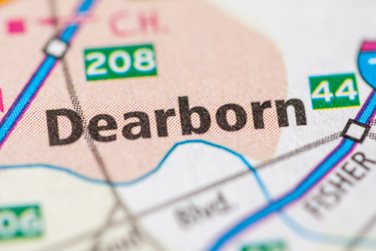 Dedicated to the expansive American spirit of innovation and “can-do” attitude, the Henry Ford Museum offers the broadest possible interpretation of both.
Dedicated to the expansive American spirit of innovation and “can-do” attitude, the Henry Ford Museum offers the broadest possible interpretation of both.
Henry Ford’s Ford Motor Company may be the first iconic American company that began in a garage — or shed — behind the founder’s home. While Henry Ford was employed as an engineer at the Edison Illuminating Company, he tinkered in his spare time with a “horseless carriage” prototype. In 1896, he unveiled “The Quadricycle,” a light metal frame carriage and a gasoline engine propelling the vehicle’s four bicycle tires. The invention proved so popular that Ford launched his own motor company in 1903.
In 1908, Ford unveiled the biggest game-changer in American automotive and manufacturing history: The Model T Ford. Sturdy, simple, and reliable, the Model T was considered reasonably-priced for those who could afford this new-fangled mode of transportation. Ford’s visionary ambition was to significantly increase that narrow segment of the American population to a majority by lowering the unit price of the Model T.
Ford studied assembly line methods in use at Detroit’s many mills, canneries, and the meat-packing plants of Chicago, and set out to apply these to his own manufacturing process. By breaking down the labor process to assemble a Model T into 84 distinct steps, Ford created a highly efficient, fluid assembly line. On December 1, 1913, Ford’s assembly line was first put into practice, reducing the time to assemble a Model T from twelve hours down to a mere two and a half. By 1918, almost half of the cars in America were Model Ts, and in 1924, the ten-millionth Model T rolled off Ford’s iconic moving chassis assembly line.
Ford’s gamble paid off, and his assembly line became standard across all industries, not only in America but throughout the world.
Henry Ford’s innovation, ingenuity and ultimate success are indicative of the expansive attitude of America in the late nineteenth and early twentieth century. This spirit of “can do” and optimistic sense of limitless possibility is captured in the excellent museum that bears Ford’s name and is dedicated to that spirit of American innovation. Founded in 1929, The Henry Ford has undergone several iterations, including a significant makeover in 2003 and another in 2017, when it was renamed The Henry Ford Museum of American Innovation.
The curators of The Henry Ford chose to interpret “innovation” in its broadest possible sense, and today the museum explores far more than the American automotive experience. In addition to highlighting the vital role played by railroad, firearm, and home arts manufacturing in the development of the United States, the museum delves into the idea of “Liberty and Justice for All” — a notion highly innovative when first introduced. This exhibit traces the nation’s ongoing quest to grant freedom for all citizens through the lens of four struggles: revolutionary, anti-slavery, women’s suffrage, and civil rights.
There is something for everyone at The Henry Ford, but we’ve curated seven must-see components we think capture both the essence of the museum as well as the American experience itself:
1. Rosa Parks’ Bus: on December 1, 1955, in Montgomery, Alabama, Rosa Parks refused to give up her seat on the bus to a white man; a tiny gesture of defiance that would ignite the Civil Rights Movement in America. That bus has been preserved in The Liberty and Justice for All exhibit. Climb aboard and take a moment to honor Rosa’s contribution to the ongoing effort to make all Americans equal.
2. The Dymaxion Home: Buckminster Fuller’s attempt to employ assembly line methods to create affordable housing for all was ultimately a failure, but the unique design of this lightweight circular dwelling — “dynamic, maximum, tension”— had a profound impact on home design in the twentieth century.
3. John F. Kennedy’s Limousine: The 1961 Lincoln Continental in which Kennedy was assassinated in 1963 occupies pride of place in the Presidential Vehicles exhibit, which includes Theodore Roosevelt’s brougham and Ronald Reagan’s car.
4. The 1896 Quadricycle: Henry Ford’s original “horseless carriage” is on display at the museum. Ford sold the Quadricycle, but bought it back at a considerable loss for sentimental reasons: one of the few deals that did not turn a profit for the American entrepreneur.
5. Lincoln’s Rocker: Abraham Lincoln was sitting on this rocker when he was assassinated in 1865 at Ford’s Theater. You can still see the bloodstains.
6. The Allegheny Locomotive: American history is intrinsically linked to the development of the railroads that crisscrossed the continent. At 125-feet and weighing 770,000 lbs., the Allegheny Locomotive was one of the largest steam locomotives ever built, designed to carry tons of coal through the twisting tracks of the Pennsylvania mountains.
7. Build a Model T: Henry Ford’s assembly line did not initially meet with enthusiasm by those who operated it. It took a substantial rise in wages to entice workers to brave both the tedium of the line as well as Ford’s exacting standards. In this interactive experience, visitors can experience what it took to assemble a Model T from the vantage point of a worker on the line.
Alexander+Roberts invites you to experience American innovation at its finest on our popular
America’s Great Lakes Cruise, during which we visit the Henry Ford Museum in Dearborn Michigan. Ask our knowledgeable reservation agents for more details.